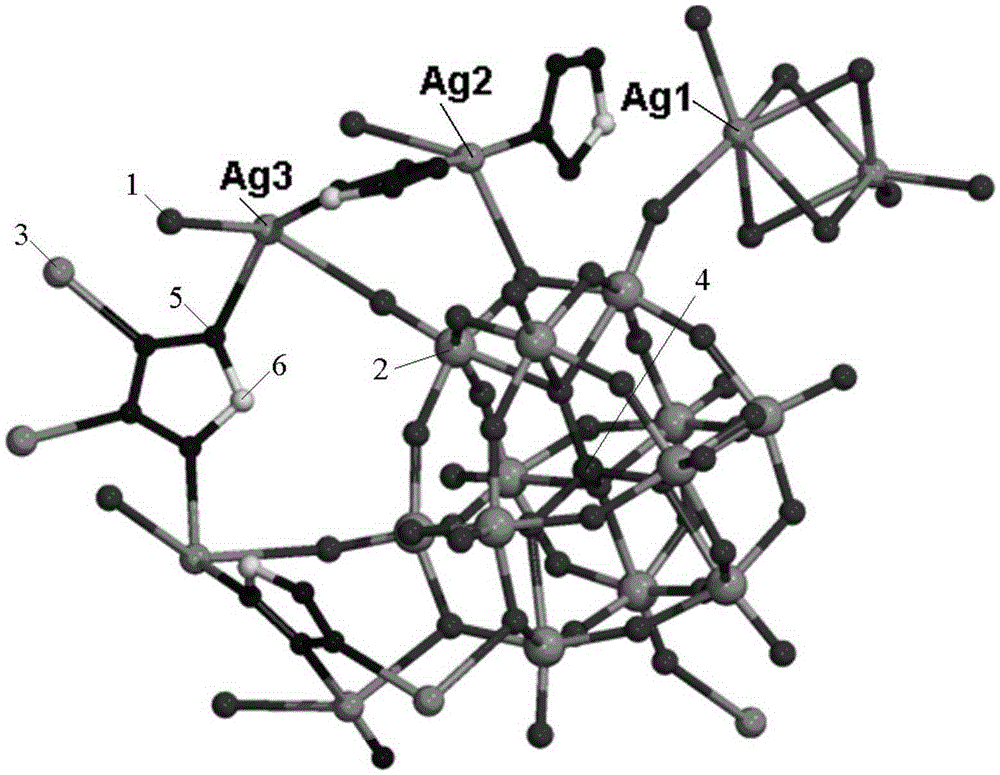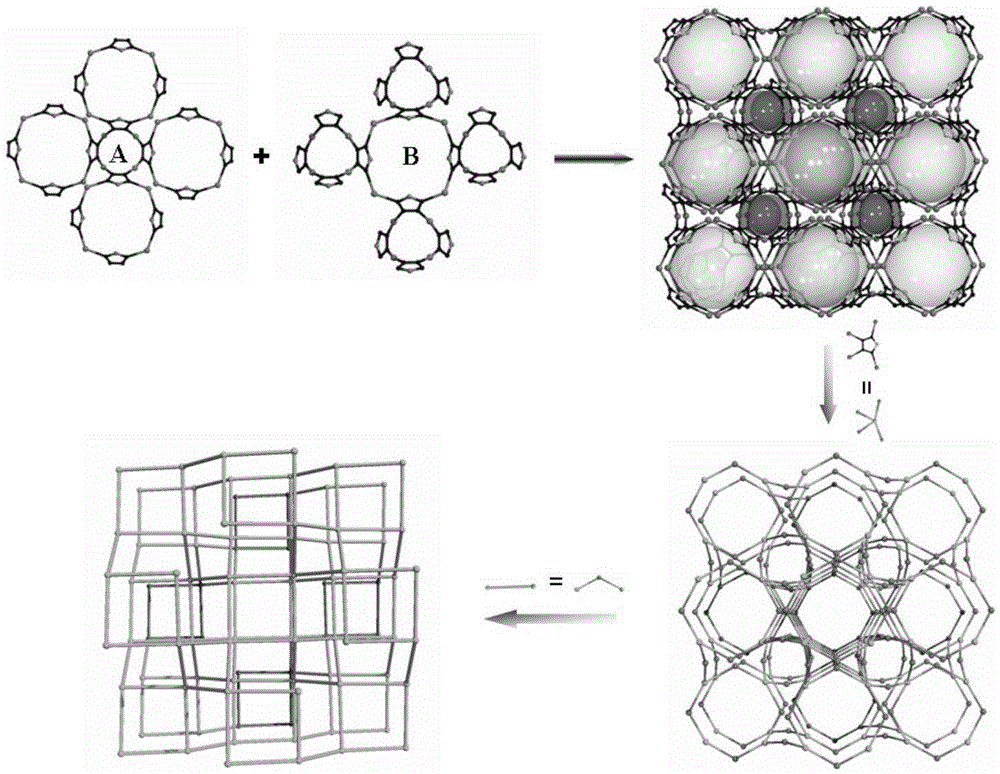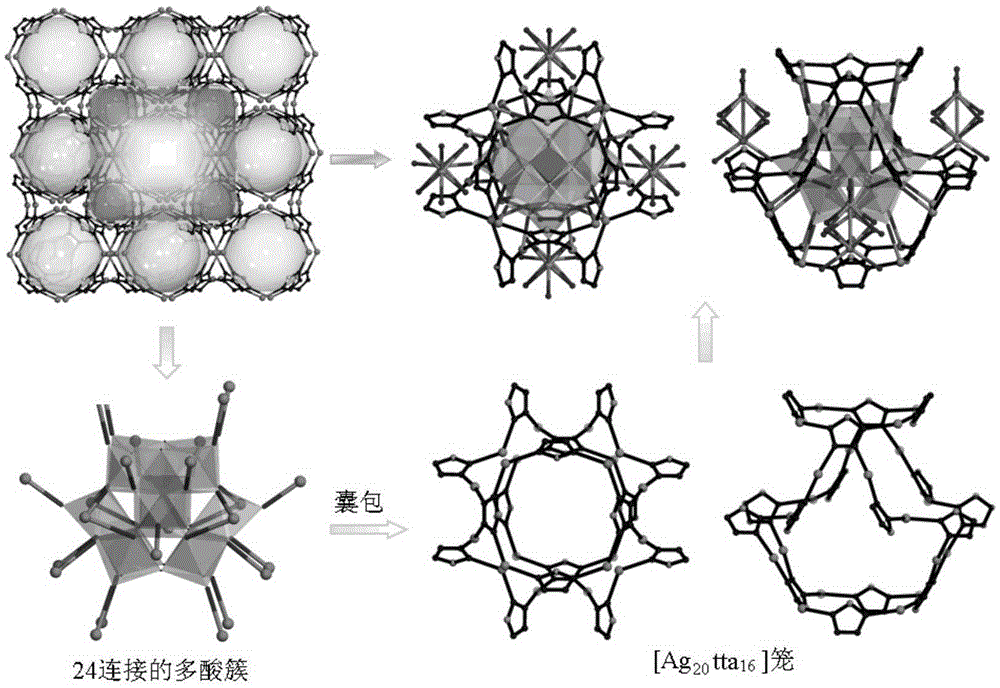Polyoxometalate-based metal-organic frameworks crystalline material with nano-cage structure and preparation method and application thereof
An organic framework and base metal technology, which is applied in the field of metal-organic framework crystalline materials, can solve the problems of difficult POMOFs crystalline materials and poor degradation of rhodamine B organic dyes, etc., and achieves easy recovery and multiple use. good effect
- Summary
- Abstract
- Description
- Claims
- Application Information
AI Technical Summary
Problems solved by technology
Method used
Image
Examples
specific Embodiment approach 1
[0026] Embodiment 1: This embodiment is a polyacid-based metal-organic framework crystalline material with a nano-cage structure, the chemical formula of which is Ag 10 (tta) 4 (H 2 O) 4 (SiW IV 10 W V 2 o 40 ), wherein, tta is tetrazole; crystal system is tetragonal; space group is I-4m2; unit cell parameter is α=90°, β=90°, γ=90°, Z=2.
[0027] The Ag described in this embodiment 10 (tta) 4 (H 2 O) 4 (SiW IV 10 W V 2 o 40 In ), IV represents that the valence of W is +4, and V represents that the valence of W is +5.
[0028] Compared with the prior art, this embodiment has the following characteristics:
[0029] This embodiment adopts simple hydrothermal synthesis technology, and for the first time, a polyacid-based metal-organic framework crystalline material with a nano-cage structure is successfully prepared by using multi-dentate ligands tetrazolium and silicotungstic acid; the results of single crystal X-ray diffraction show that, The polyacid-based met...
specific Embodiment approach 2
[0031] Embodiment 2: This embodiment is a method for preparing a polyacid-based metal-organic framework crystalline material with a nano-cage structure, which is completed in the following steps:
[0032] 1. Prepare a reaction solution with a pH value of 2.5: Dissolve silicotungstic acid, metal silver salt, tetrazolium and mineralizer in distilled water to obtain a reaction solution; adjust the pH value of the reaction solution to 2.5 to obtain a pH value of 2.5 reaction solution;
[0033] The molar ratio of the silicotungstic acid described in step 1 to the metal silver salt is 0.1:(1.0~2.0);
[0034] The molar ratio of silicotungstic acid and tetrazole described in step 1 is 0.1:(0.4~1.0);
[0035] The molar ratio of silicotungstic acid and mineralizer described in step 1 is 0.1:(0.2~0.8);
[0036] The volume ratio of the amount of silicotungstic acid described in step 1 to distilled water is 0.1mmol:(10mL~12mL);
[0037] 2. Add the reaction solution with a pH value of 2....
specific Embodiment approach 3
[0041] Embodiment 3: The difference between this embodiment and Embodiment 2 is that the metal silver salt described in step 1 is silver nitrate, silver acetate or silver sulfate. Others are the same as in the second embodiment.
PUM
| Property | Measurement | Unit |
|---|---|---|
| catalytic efficiency | aaaaa | aaaaa |
| catalytic efficiency | aaaaa | aaaaa |
Abstract
Description
Claims
Application Information
 Login to View More
Login to View More - R&D
- Intellectual Property
- Life Sciences
- Materials
- Tech Scout
- Unparalleled Data Quality
- Higher Quality Content
- 60% Fewer Hallucinations
Browse by: Latest US Patents, China's latest patents, Technical Efficacy Thesaurus, Application Domain, Technology Topic, Popular Technical Reports.
© 2025 PatSnap. All rights reserved.Legal|Privacy policy|Modern Slavery Act Transparency Statement|Sitemap|About US| Contact US: help@patsnap.com



